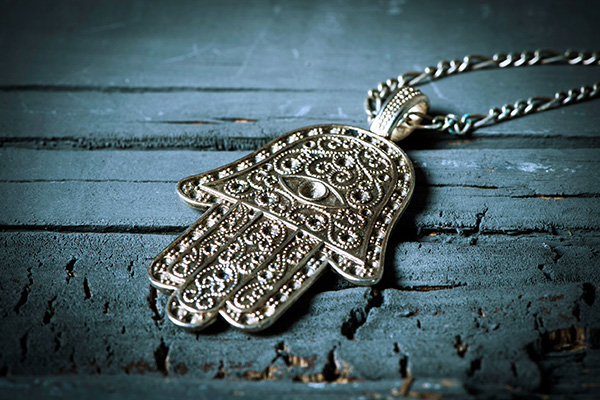 The widely recognized Hamsa symbol holds deep and mysterious significance across various cultures and religions like Islam, Judaism, and Christianity. It serves as a powerful shield against the malevolent gaze, acting as a protective amulet. Additionally, it acts as a talisman and brings good fortune, happiness, and sound health to those who wear it as a lucky charm.
The widely recognized Hamsa symbol holds deep and mysterious significance across various cultures and religions like Islam, Judaism, and Christianity. It serves as a powerful shield against the malevolent gaze, acting as a protective amulet. Additionally, it acts as a talisman and brings good fortune, happiness, and sound health to those who wear it as a lucky charm.
The Hamsa, alternatively called Khamsa, Hamesh, the Hand of Fatima, the Hand of Miriam, or the Hand of Mary, is symbolically associated with the number five in Arabic and Hebrew, representing the five fingers of a hand.
In Islamic tradition, this famous esoteric hand is named after Fatima al-Zahra, the youngest daughter of the Prophet Muhammad and his first wife Khadija. Fatima is known by many titles in Islamic tradition, of which al-Zahra (meaning “the Radiant One”) is one of the most prominent. Her life, devotion to family and faith, and moral integrity are admired and serve as an inspiration to Muslims around the world.
In Jewish culture, the hand symbol is named after Miriam, the sister of Moses and Aaron, who was a prophetess and is an important figure in Judaism. In some Christian contexts, it is also known as the Hand of Mary, although it is less commonly referred to by this name. In this instance it is associated with Mary, the mother of Jesus, who is revered for her purity, grace, and maternal protection.
Across various traditions, the symbol holds a consistent significance of safeguarding against negative energies, warding off the malevolent gaze, and attracting positive luck, despite being known by different names and associated with various beliefs.
Hamsa, while having origins among pagan societies in antiquity, is clearly no longer exclusively associated with the specific practice of a discernibly idolatrous religion, as Jews, Christians, and Muslims alike revere the symbol ~ Daniel Sayani
The Symbolism Of Five
The mystical number five weaves its way through many faiths and wisdom traditions. In Islam, five represents the five pillars that guide the spiritual life: faith, prayer, charity, fasting, and pilgrimage. Each of the five fingers of the Hand of Fatima is intertwined with a pillar, representing a sacred path. The open hand reflects the pillars in its shape and becomes a manifestation of spiritual devotion. Beyond doctrine, it signifies God’s omnipresent protection from evil and misfortune.
In the Christian faith, the hand symbolizes the five sacred wounds suffered by Christ during his crucifixion. Each finger represents a specific wound, including those on his palms, feet, and side. This depiction underscores the significance of Christ’s sacrifice and suffering in redeeming humanity, making it a powerful symbol of divine love and salvation.
In the Jewish faith, the number five holds significance as it represents the five books of Moses found in the Torah. Additionally, the orientation of the hand’s five fingers can symbolize the Hebrew letters that spell out God’s name, serving as a manifestation of divine presence.
In hermetic and alchemical practices, the number five frequently relates to the idea of the “quintessence” or the “fifth element.” This element goes beyond the traditional four physical elements of Fire, Air, Water, and Earth, and symbolizes a more refined, spiritual essence that exists throughout nature and is responsible for all creation and existence. The Quintessence or fifth element known as Spirit is perceived as the harmonizing energy, the spiritual foundation of the universe that encompasses perfection and the merging of the physical and spiritual realms.
The Pentagram, a star with five points, holds significance in Hermetic mysticism and other mystical and secret traditions. Each point of the pentagram represents one of the four elements, while the fifth point represents the spirit or quintessence. It is commonly utilized as a symbol of protection, representing the unity and balance of the elements under the influence of the spirit. Furthermore, the pentagram serves as a potent instrument for summoning and dispelling energies during magical rituals.
Origins Of The Hamsa
The Hamsa is a very old symbol that has been used in many different civilizations over a long period of time. It is hard to determine exactly where it came from because it has been used by so many cultures. The symbol consists of an open right hand and is meant to represent protection, blessing, and power. It has been found in the ancient cultures of Mesopotamia, Egypt, and Phoenicia, among others. Its long history makes it one of the oldest symbols known to humans.
Artisans in the Middle East have been crafting Hamsa amulets and talismans for centuries. These objects were believed to bring good luck, fertility, and protection. Archaeological findings have unearthed various versions of these charms, representing Jewish, Christian, and Islamic faiths, with enigmatic inscriptions and spells. These ancient artifacts provide evidence of a long-lasting faith in the hand’s ability to attract divine blessings.
The Hamsa is often linked to the worship of Tanit, which began around the 5th century BC in the Phoenician city of Carthage, situated in present-day Tunisia. Tanit, along with Baal Hammon, became the main deities of Carthage and was revered as the goddess of war, fertility, and the moon. As the Carthaginians expanded their trade networks and colonies, the worship of Tanit spread across the western Mediterranean. The association between the Hamsa and Tanit is mainly based on the symbol’s protective characteristics and its representation of the divine feminine.
In the time of the Ottoman Empire, the Hamsa became very popular as it was passed along trade paths. It was used to decorate everyday items, jewelry, and holy books. Although it had its origins in pagan beliefs and Islamic culture, the Hamsa has managed to bring together diverse cultures throughout history. It has changed to become a symbol that represents common human values such as happiness, strength, and protection. The Hamsa’s symmetrical open hand demonstrates balance and welcomes positive spiritual forces.
Today, the Hamsa or Hand of Fatima resonates from North Africa to the Americas as an embodiment of the holy mysteries. Its presence in secular Western culture continues to grow, often as an exotic motif or tattoo. Wherever it travels, the essence of the symbol prevails as an ancient artifact that radiates positivity and divine protection.
The Hamsa, as it travels across the globe, serves as a unifying symbol, showcasing the interconnectedness of various spiritual customs. Whether displayed as art or worn as jewelry, it brings together different communities and serves as a reminder of our shared belief in protective symbols. In a world divided, this hand symbolizes our universal desire for divine safeguarding.
The Hand of Fatima, shown painted on a house wall in Algeria, is a powerful charm and sacred symbol used in Arab and Muslim lands to protect the innocent from evil jinn or demons and from the effects of the ‘evil eye’ ~ Robert W. Lebling
The Hamsa As An Amulet
Amulets serve primarily as a means of protection, guarding against negativity, harm, malevolent entities, or illnesses. Their main purpose is to provide defense. The term “amulet” derives from the Latin word amuletum, which describes an object intended to safeguard an individual from adversities.
The Hamsa, characterized by an open right hand, is a potent symbol that is widely acknowledged globally and in various religions for its protective attributes. While its names and associated representations may differ across different cultures, the Hamsa consistently possesses a protective nature. As a talisman, the Hamsa is believed to repel negative luck, curses, and the malevolent gaze.
The Hamsa is most often utilized in spiritual and metaphysical rituals as a talisman that guards against the harmful effects of the evil eye, a malevolent stare thought to cause misfortune, illness, or harm to the target. This symbol functions as a shield of protection, either absorbing or redirecting the negative energies commonly associated with the evil eye.
The Hamsa is often interpreted within religious settings as the Hand of God, serving as a symbol of heavenly safeguarding and involvement. It signifies the existence of God in the person’s life, offering solace and assurance.
The Hamsa is widely utilized in various cultures because it represents protection that goes beyond religious and cultural differences. It acts as a connection between traditions, promoting a sense of shared humanity and respect. As a protective amulet, it represents humanity’s universal longing for safety, peace, and good health. Its sustained popularity demonstrates its potent symbolism and our shared requirement for protection against unseen negative forces.
The Hamsa As A Talisman
The Hamsa is a well-known amulet that offers protection. However, it also functions as a talisman, carrying positive energies and intentions to bring specific benefits to the person who wears or owns it. The term “talisman” originates from the Greek word telesma, meaning a sacred or consecrated object. Talismans are often charged or consecrated with a specific purpose or intention. The Hamsa is commonly used to attract good luck, wealth, well-being, love, spiritual development, or improved psychic abilities.
Wearing a Hamsa talisman attracts positive energies, blessings and good fortune. It encourages the flow of beneficial influences, helping to improve various aspects of one’s life. It is believed to open doors to opportunity, success, and prosperity, making it a popular symbol among those seeking to improve your personal luck.
The Hamsa amulet is also connected to good health and joy. By creating a positive atmosphere and attracting positive energies, it is believed to enhance the overall happiness and satisfaction of the person wearing it. In certain societies, the Hamsa is additionally linked to fertility and prosperity, thus becoming a favored charm for individuals desiring to have a family or seeking abundance in different areas of their life.
The Hamsa is often seen as a charm for personal development and awakening. It symbolizes a link to the sacred and provides reassurance and guidance throughout one’s spiritual path. The hand signifies divine blessings and safeguarding, promoting an atmosphere of serenity and divine companionship.
The Hamsa symbolizes more than just protection from harm; it represents the desire for positive outcomes and fulfillment in life. With its role as both an amulet and talisman, it is a powerful symbol that brings protection and blessings to believers.
Below are effective methods to incorporate the Hamsa into your routine spiritual activities:
Many individuals choose to wear or showcase the Hamsa as a form of jewelry, such as necklaces, bracelets, earrings, or charms. This is done with the intention of repelling negative energies and drawing in positive energies. The manner in which it is worn or displayed can be customized to optimize its efficacy as a protective amulet. Incorporating it into the decor of your residence or workplace not only enhances its beauty but also fills the space with its shielding and beneficial attributes. By positioning it in your home, particularly near the entrance, it is thought to safeguard the household from unfavorable influences.
Hamsa amulets or talismans can be created using various materials such as metal, ceramic, wood, and stone. The quality of craftsmanship and types of materials utilized can enhance the desired properties of the talisman. For optimal outcomes, it is recommended to create the talisman with specific intentions in mind, or personalize it with symbols, inscriptions, or gemstones that align with your desires or needs. Additional symbols often incorporated for added protection or blessings include fish (symbolizing prosperity and good luck in certain cultures), eyes (providing extra safeguard against the evil eye), or specific prayers and inscriptions. By setting an intention or bestowing a blessing upon the symbol, its effectiveness can be heightened.
The Hamsa can be utilized as a central point for concentration during meditation or prayer. Contemplating on this symbol aids in cultivating feelings of safeguarding, serenity, and connection to the spiritual realm. Additionally, it can assist in directing one’s focus towards the virtues it embodies, such as resilience, composure, and belief. By incorporating the Hamsa in your prayers, it serves as a constant reminder of divine protection and guidance. This practice can enhance your faith and reliance on the higher power, particularly during moments of doubt or difficulty.
Practicing Gratitude: Having the Hamsa nearby while going about your daily tasks can remind you to be mindful and appreciative of the blessings in life. It promotes a habit of focusing on the positive and warding off negative thoughts or influences. Offering the Hamsa as a gift is a thoughtful gesture to wish others good fortune, protection, and joy. It allows you to spread the positive energies and blessings associated with the symbol to those around you.
Manifestation Practice: Using the Hamsa in manifestation practice involves using its symbolic power to attract positive energies to assist in the realization of personal goals and desires.Choose a Hamsa that resonates with you. This could be a piece of jewelry, a wall hanging, or any representation of the Hamsa to which you feel connected.
Make sure to clearly define your intentions or what you want to bring into your life. Whether it is safeguarding, well-being, abundance, romance, or spiritual progress, it is crucial to understand your aspirations. Grasp the Hamsa symbol in your hands, shut your eyes, and envision your intentions transferring into it. Picture the symbol radiating with vitality as it absorbs your desires. Certain individuals prefer to do this ritual during a significant moment like a new moon to amplify the energy.
You can also set aside a space for your manifestation work and place your hamsa there. Surround it with other items that support your intentions, such as crystals, candles, or written affirmations. Each day, sit in your sacred space and hold or look at your Hamsa while reciting affirmations that align with your intentions. This practice reinforces your desires and strengthens the connection between you and the energies you wish to attract.
Incorporating the Hamsa into one’s daily spiritual practice can vary greatly depending on your personal beliefs and the traditions you follow. It’s important to approach its use with respect for its cultural and religious significance. Beyond faith and religion, the Hamsa holds limitless personal meaning. For some, it honors cultural ties and family lineage. For others, it channels unseen spiritual forces into physical form. Harness your own interpretations of the ageless wisdom of the Hand.
|
 About The Author: Paul About The Author: Paul
Paul is currently living out his dream in Buenos Aires, providing counseling to those in his busy neighborhood. This was the exact place he had always hoped to live since he was a child. He was born with an ability to see things that others cannot, and he wanted to explore this further. So, he became a student at a well-known esoteric school where he learned how to tap into the Divine Presence using Tarot cards and the Runes with the help of a Master. Paul also studied Qabalah and Ceremonial Magic, and together with some friends, he formed a research group that focused on applying spiritual principles to everyday life. For more than twenty years, he has been sharing his abilities and knowledge with others, which has made him a popular teacher and a highly respected counselor with intuitive abilities. If you are interested in uncovering the deeper meanings of your situation and are ready to embark on a journey that will provide you with clear answers and fulfillment in your life, you can find Paul at PsychicAccess.com.
|
The Hamsa, also known as the Hand of Fatima or Hand of Miriam, is a widely recognized symbol found in different cultures and religions. It consists of a hand with an eye in the center and carries significant symbolic meaning for its wearers or displayers. In this article, we will explore the origins and meaning of the Hamsa symbol.
The Hamsa has a rich history dating back thousands of years and originated in the Middle East and North Africa. It is believed to have originated in ancient Mesopotamia and later adopted by Judaism, Islam, and Christianity. In spite of the variations in interpretations across these religions, the Hamsa remains a symbol of protection and good luck.
A common interpretation of the Hamsa is its association with protection against the evil eye. The evil eye is the belief that some individuals have a harmful gaze capable of bringing misfortune to others. The Hamsa is believed to ward off this negative energy and act as a shield of protection. It is frequently worn as jewelry or displayed in homes and businesses to bring good fortune and safeguard against harm.
In Judaism, the Hamsa is known as the Hand of Miriam, symbolizing Moses and Aaron’s sister. It is seen as a symbol of female power and strength. In this context, the Hamsa is associated with fertility, abundance, and maternal blessings. It is often given as a gift to expectant mothers or used as a decorative element in nurseries.
In Islam, the Hamsa is referred to as the Hand of Fatima, named after Prophet Muhammad’s daughter. It holds significant meaning in Islamic culture as a symbol of divine protection and blessings. The Hamsa’s five fingers represent the Five Pillars of Islam: faith, prayer, charity, fasting, and pilgrimage. It is believed to bring blessings, happiness, and good fortune to its possessors.
Apart from its religious connotations, the Hamsa has become a popular symbol in modern culture. It is embraced by individuals seeking spiritual connection and protection, regardless of their religious background. The Hamsa’s universal appeal lies in its ability to transcend boundaries and unite people under a shared belief in the power of positive energy and protection.
Recently, the Hamsa has gained popularity in the fashion industry and can be found on clothing, accessories, and tattoos. However, it is important to approach the symbol with respect and understanding of its cultural and religious significance. The Hamsa should not be appropriated or misused, as it can be offensive to those who hold it sacred.
In conclusion, the Hamsa is a symbol with deep meaning across different cultures and religions. It represents protection against the evil eye, good luck, and blessings. Whether worn as jewelry or displayed in homes, the Hamsa serves as a reminder of the power of positive energy and the importance of spiritual connection.
Continue reading →
 From the beginning of my psychic career, the information in my readings has always come from both spirit guides and angels. I find that the energy of these two types of spirit beings are very similar in the way they present themselves, but there are different nuances in the messages they convey. In the early […] Continue reading
From the beginning of my psychic career, the information in my readings has always come from both spirit guides and angels. I find that the energy of these two types of spirit beings are very similar in the way they present themselves, but there are different nuances in the messages they convey. In the early […] Continue reading 


